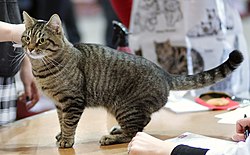This article needs additional citations for verification .(February 2021) |
| European Shorthair | |
|---|---|
 Red blotched tabby European Shorthair | |
| Other names | Celtic |
| Origin | Sweden [1] [2] [3] |
| Foundation bloodstock | European landrace population |
| Breed standards | |
| FIFe | standard |
| WCF | standard |
| LOOF | standard |
| Domestic cat (Felis catus) | |
The European Shorthair, also known as the European [4] and Celtic/European Shorthair, [5] is a pedigreed breed of domestic cat. The breed's name has also been erroneously used to describe the non-pedigreed landrace domestic cat of Europe, causing confusion as the pedigreed cats of this breed also should resemble the typical domestic cats of Europe.
Contents
- History
- Origin
- Breed recognition
- Appearance
- Coat
- Health
- Temperament
- Popularity
- Gallery
- See also
- References
- External links
The role as the cat breed resembling the original domestic cats of Europe was held until the beginning of the 20th century by the British Shorthair, even though stockier than the majority of common European cats, until 1949 when the European Shorthair was recognised by the Fédération internationale féline (FIFe). The oldest known European Shorthair registered in FIFe was born in 1940.[ citation needed ]








